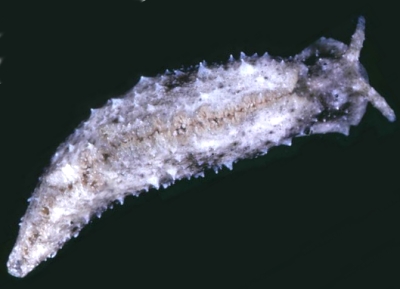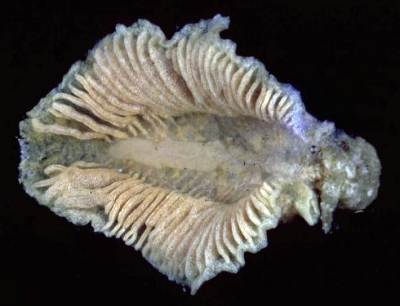

Pattyclaya arena
(Carlson & Hoff, 1977)
Order: SACOGLOSSA
Superfamily: ELYSIOIDEA
Family: Elysiidae
DISTRIBUTION
Known only from Guam.
PHOTO
Upper: 27mm long alive. Guam, Cocos Lagoon, reef flat. 1 m. 13 May 1971 Host: Caulerpa racemosa. Lower: 19 mm long alive, showing open parapodia ; Guam, Cocos Lagoon, Sand Island; 13 Oct 1973. Photographer: Carlson & Hoff.
Animals are described as heavy bodied and range in size up to 32 mm in length. The body and parapodia are covered in conical projections. The most distinctive feature is the band of large transverse lamellae which occupy the outer half of of the inside face of the parapodia. The colour is brownish with white and reddish brown markings. The foot is a yellowish green.and the internal dorsal surface is a translucent pale green.
The animals have only been found in shallow lagoonal deposits buried just under the surface of the sand amongst the rhizoids of the green algae Caulerpa cupressoides and C. racemosa.
-
Carlson, C. H. and Hoff, P. J. (1977) A sand-dwelling Elysia from Guam (Opisthobranchia: Sacoglossa). The Veliger, 20: 14-16.
-
Carlson, C.H. & Hoff, P.J. (1978) The identifiable Elysia from Guam (Elysiidae, Sacoglossa, Opisthobranchia). Micronesica, 14: 89-113.
-
Jensen, K.R. (1992) Anatomy of some Indo-Pacific Elysiidae (Opisthobranchia: Sacoglossa (=Ascoglossa), with a discussion of the generic division and phylogeny. Journal of Molluscan Studies,. 58(3), 257-296.
Rudman, W.B., 2006 (April 20) Pattyclaya arena (Carlson & Hoff, 1977). [In] Sea Slug Forum. Australian Museum, Sydney. Available from http://www.seaslugforum.net/find/pattaren
Related messages
Pattyclaya / Elysia cf arena
April 26, 2006
From: Cynthia Trowbridge
Dear Bill,
Hi! In November or December 2005, the Hiranos and I found this species or a closely related undescribed "Pattyclaya " species on the west coast of Okinawajima (main island of Okinawa).
Three points:
1. In message #16395, you asked about the demise of the genus name Pattyclaya... it was in Gosliner (1995). Terry stated "Continued usage of the genera Elysiella, Plattyclaya [should be Pattyclaya], Tridachia and Tridachiella renders Elysia paraphyletic..." p. 1.
2. Hamatani (2000) reported Pattyclaya sp. from Okinawa (pp. 764-765). Regretfully, Hamatani has not yet published why he considered it different from P. arena. Clay suggested to me that Hamatani felt there were differences in coloration.
3. To be conservative, we are calling our Okinawa species Elysia cf. arena. Externally our species has the same general appearance and pattern of parallel transverse lamellae inside the parapodia as Elysia arena Carlson & Hoff (1977). Once we dissect the radula and examine the species in more detail, we will let you know: if our species is E. arena, then our record will represent a range extension from the type locality.
-
Gosliner, T.M. (1995) The genus Thuridilla... Proc. Calif. Acad. Sci. 49(1): 1-54.
-
Hamatani (2000) in Marine mollusks in Japan edited by Takashi Okutani. Tokai Daigaku Shuppankai, Tokyo.
Cordially,
Cynthia
trowbric@yahoo.com
Trowbridge, C.D., 2006 (Apr 26) Pattyclaya / Elysia cf arena. [Message in] Sea Slug Forum. Australian Museum, Sydney. Available from http://www.seaslugforum.net/find/16420Dear Cynthia,
Thanks for your response. As you will see Clay & Patty-Jo have sent some photos of P. arena and Corey Whisson has sent a nice photo showing the transverse lamellae in P. brycei. As I said in reply to his message I remembered Terry's paper soon after posting my query. I am being even more conservative than you in retaining Pattyclaya, at least temporarily. It would be interesting if you do have another species of this transverse lamellae group.
Best wishes,
Bill Rudman
Re: Pattyclaya arena from Guam
April 22, 2006
From: Clay Carlson
Concerning message #16407:
Bill,
A specimen of P. arena was found in Palau (Gary Williams) when we were there in 1996. Also in Marine Mollusks in Japan, 2000, Pl. 380, fig. 3 shows a specimen listed as Pattyclaya sp. from Okinawa which is probably the same.
Clay Carlson
ccarlson@guam.net
Carlson, C., 2006 (Apr 22) Re: Pattyclaya arena from Guam. [Message in] Sea Slug Forum. Australian Museum, Sydney. Available from http://www.seaslugforum.net/find/16423Thanks Clay,
Bill Rudman
Pattyclaya arena from Guam
April 22, 2006
From: C. Carlson & P-J Hoff


Concerning message #16395:
Bill,
Here are some examples of Pattyclaya arena (Carlson & Hoff, 1977), to go with the P. brycei note. We think the lamellae are related to subsand habitat and have no idea if there will be enough genetic difference between P. arena and the other Caulerpa feeding Elysia to merit a different genus.
Our last Guam record for the animal was in Nov. '75. The type locality was damaged by a typhoon and later became a jet ski area for a neighboring hotel.
Upper: 27mm long alive. Guam, Cocos Lagoon, reef flat. 1 m. 13 May 1971 Host: Caulerpa racemosa. Middle: 19 mm long alive, showoing open parapodia ; Guam, Cocos Lagoon, Sand Island; 13 Oct 1973. Lower: 25 mm long alive. in situ; Guam, Cocos Lagoon, Sand Island; 13 Oct 1973. Photographer: Carlson & Hoff.
Clay & Patty-Jo
ccarlson@guam.net
Carlson, C. & Hoff, PJ, 2006 (Apr 22) Pattyclaya arena from Guam. [Message in] Sea Slug Forum. Australian Museum, Sydney. Available from http://www.seaslugforum.net/find/16407
Dear Clay & Patty-Jo,
Thanks for photos of your Pattyclaya arena. It is fascinating to see how they sit in the sand. Are the lamellae full of plastids? If so, perhaps it has found another way of solving the problem of too much light in a different way to Plakobranchus ocellatus which also lies just under the sand. I think - with no evidence however- that the coral sand pools that these animals live in is too bright for photosynthesis. I suspect that Plakobranchus cuts down the light intensity to optimum levels for photosynthesis by placing its stolen chloroplasts in longitudinal ridges on the inside of the parapodia where they receive only filtered sunlight. Perhaps in Pattyclaya the same thing is happening but the chloroplasts are in tranverse lamellae rather than longitudinal ridges. Something for someone to investigate.
Best wishes,
Bill Rudman
